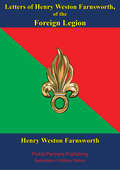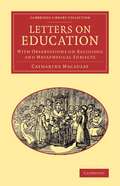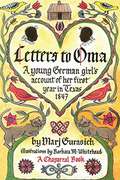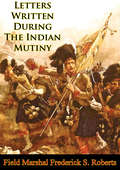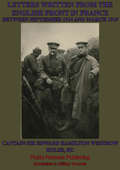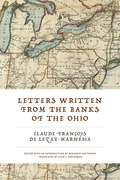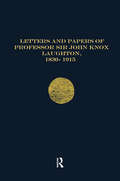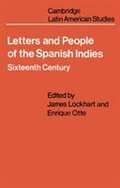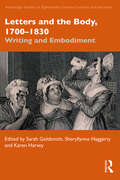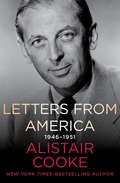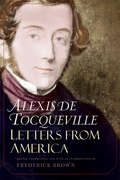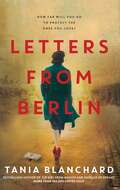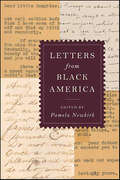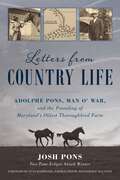- Table View
- List View
Letters Of A Civil War Surgeon
by Major William Watson Prof. Paul Fatout"From September 1862 until May 1865, Major William Watson served as surgeon with the 105th Regiment of Pennsylvania Volunteers, which fought at Fredericksburg, Chancellorsville, Gettysburg, the Wilderness, and elsewhere. Over the course of three years at war, he wrote 91 letters to his family, in which he describes his own war against death and disease. This well-educated and sensitive young man has left us a variety of impressions of camp life, marches, and battles; of a soldier's matter-of-fact willingness to accept-though not without grumbling-the rigors of his lot, of concern with the job at hand and with immediate needs like food and shelter; and of a veteran's indifference to the flag-waving of professional patriots. In spite of his often acute criticisms of the Union's military leadership, Watson never faltered in his belief in the Union cause and the ultimate outcome of the war nor in his dedication to Lincoln's major goals."-Print ed.
Letters Of Henry Weston Farnsworth, Of The Foreign Legion
by Henry Weston FarnsworthThe French Army have had numerous foreign regiments in its service for centuries; however, few have the mystique and elite status of the French Foreign Legion. It became a haven for the rough, tough, and adventure-seeking crowds of all of Europe. Bred with a fierce and disciplined esprit de corps, these soldiers could expect to fight France's enemies even in the most desperate of circumstances.With the clouds of war gathering over Europe in the early years of the Twentieth Century, the Legion attracted volunteers from even further afield, including the wealthy American adventurer and traveller Henry Weston Farnsworth. He volunteered for service early in late 1914 and was thrown together with a diverse bunch of men from a number of countries, some of whom he would bond with closely. His pen portraits in his letters to his family are filled with these characters and the experiences he had in the front-lines. However, Farnsworth would fight among his new friends for only a few months as the fighting in France grew ever more fierce and his unit was thrown into the battles in Champagne during which he died.
Letters Of The Century: America 1900-1999
by Lisa Grunwald Stephen J. AdlerMore than 400 letters from famous people and regular citizens giving voice to events throughout the century.
Letters On Education: With Observations On Religious And Metaphysical Subjects (Cambridge Library Collection)
by Catharine MacaulayFirst published in 1790, this collection of letters presents the mature views of Catharine Macaulay (1731-91) on education and related topics. Famed as an impassioned writer on history and politics, she defied eighteenth-century preconceptions of what it was possible and appropriate for women to achieve. Ranging across a broad spectrum of subjects, from diet and reading to pastimes, religion and discipline, this work reflects her enlightened thinking. She compares the educational situation in England to the contemporary French and American systems, and even those of ancient Rome and Sparta. Championing equality in education regardless of gender, Macaulay argues for the instruction of girls within a co-educational system, seeing this as the only way to improve female standing in society. Also reissued in this series is her eight-volume History of England (1763-83), which traces the upheavals of the seventeenth century.
Letters On Strategy Vol. I [Illustrated Edition] (Letters On Strategy #1)
by General August Eduard Friedrich Kraft zu Hohenlohe-IngelfingenIncludes over 30 maps and plans of the actions described in this volume.'The late Prince Kraft zu Hohenlohe Ingelfingen was not only known as one of Prussia's ablest soldiers, but also as one of the best of German military authors. During the wars of 1866 and 1870 he commanded the Artillery of the Guard, and in the latter portion of the Franco-German struggle he directed the artillery operations against Paris. After the termination of the war he held several high positions of command.His best-known works are:--"On the Employment of Artillery in combination with the other Arms," translated by the late Major Clarke."Letters on Infantry, Cavalry, and Artillery," which have been ably rendered into English by Colonel Walford, Royal Artillery."Conversations on Cavalry," recently translated by Captain Maude, late Royal Engineers.The "Letters on Strategy," which are contained in this volume, form an able treatise on this portion of the art of war. They are not to be taken up lightly, or to be dipped into here and there, but conscientiously studied they form a valuable means of instruction in strategical matters, and for this reason they are placed before the British military reader.'-Introduction
Letters On Strategy Vol. II [Illustrated Edition] (Letters On Strategy #2)
by General August Eduard Friedrich Kraft zu Hohenlohe-IngelfingenIncludes over 30 maps and plans of the actions described in this volume.'The late Prince Kraft zu Hohenlohe Ingelfingen was not only known as one of Prussia's ablest soldiers, but also as one of the best of German military authors. During the wars of 1866 and 1870 he commanded the Artillery of the Guard, and in the latter portion of the Franco-German struggle he directed the artillery operations against Paris. After the termination of the war he held several high positions of command.His best-known works are:--"On the Employment of Artillery in combination with the other Arms," translated by the late Major Clarke."Letters on Infantry, Cavalry, and Artillery," which have been ably rendered into English by Colonel Walford, Royal Artillery."Conversations on Cavalry," recently translated by Captain Maude, late Royal Engineers.The "Letters on Strategy," which are contained in this volume, form an able treatise on this portion of the art of war. They are not to be taken up lightly, or to be dipped into here and there, but conscientiously studied they form a valuable means of instruction in strategical matters, and for this reason they are placed before the British military reader.'-Introduction
Letters To My Grandchildren: Lessons For The Future
by Tony BennAs a diarist I have chronicled the time through which I have lived in meticulous detail: but all that is history. What matters now is the future for those who will live through it.The past is the past but there may be lessons to be learned which could help the next generation to avoid mistakes their parents and grandparents made.Certainly at my age I have learned an enormous amount from the study of history - not so much from the political leaders of the time but from those who struggled for justice and explained the world in a way that shows the continuity of history and has inspired me to do my work.Normality for any individual is what the world is like on the day they are born. The normality of the young is wholly different from the normality of their grandparents.It is the disentangling of the real questions from the day to day business of politics that may make sense for those who take up the task as they will do.Every generation has to fight the same battles as their ancestors had to fight, again and again, for there is no final victory and no final defeat. Two flames have burned from the beginning of time - the flame of anger against injustice and the flame of hope. If this book serves its purpose it will fan both flames.
Letters To Oma: A Young German Girl's Account Of Her First Year In Texas 1847
by Marjorie A. Gurasich Barbara Mathews WhiteheadWhen fifteen-year-old Christina Eudora Von Scholl learns that her family will leave their German homeland to seek freedom in Texas, her greatest sorrow is leaving behind her beloved grandmother. And so, in a series of letters, she takes “Oma” on this great adventure with her family . . . and takes us as readers. <p><p> Sometimes the letters are dark with discouragement, for the Von Scholls find, as did many German-Texas families, that the Society for the Protection of German Emigrants, known as the Adelsverein, was unable to fulfill its promises of land, housing, horses, and farm implements. But they are Germans, determined and willing to work hard. <p> More often these letters—and the text woven in between them—are bright with adventure, for Tina finds Texas an exciting, if puzzling, place. There are new customs to learn, new foods to eat, even while the family preserves its traditional German ways. Tina’s adventures include a run-in with a mountain lion, an exciting trip across Texas with her father to Sisterdale, and a frightening encounter with Lipan Indians. Her lessons in being an American are helped by Jeff, a young man who becomes part of the family when he undertakes to teach them to farm in Texas. Tina, in return, teaches Jeff to read and learns a lesson in love that is without nationality. <p> Letters to Oma is a charming, informative novel that sweeps the reader back to a very particular time and place. And Tina Von Scholl is irresistible as correspondent and as heroine.
Letters To Poseidon
by Cees Nooteboom'I had been looking for someone to write to for a long time, but how does a man write letters to a god?' From his Mediterranean garden on the island of Menorca, Cees Nooteboom writes to the trident-wielding deity, Poseidon, 'initiating a dialogue not only with the past,' as Alberto Manguel observes in his Preface, 'but with an entire world that seemed lost for ever.' Offering a seductive interweaving of keen observation and the fruits of a vast knowledge, Nooteboom explores questions of human existence through the minutiae of the living world around him, and marvels at the secrets of the deep. He recalls figures in history, places he has travelled to, objets trouvés, works of art and literature, and takes a fresh look at the ancient myths. At once playful and poignant, beautiful and bizarre, Nooteboom's Letters to Poseidon are couched in the glittering prose of one of Europe's outstanding stylists.
Letters To Poseidon
by Cees Nooteboom'I had been looking for someone to write to for a long time, but how does a man write letters to a god?' From his Mediterranean garden on the island of Menorca, Cees Nooteboom writes to the trident-wielding deity, Poseidon, 'initiating a dialogue not only with the past,' as Alberto Manguel observes in his Preface, 'but with an entire world that seemed lost for ever.' Offering a seductive interweaving of keen observation and the fruits of a vast knowledge, Nooteboom explores questions of human existence through the minutiae of the living world around him, and marvels at the secrets of the deep. He recalls figures in history, places he has travelled to, objets trouvés, works of art and literature, and takes a fresh look at the ancient myths. At once playful and poignant, beautiful and bizarre, Nooteboom's Letters to Poseidon are couched in the glittering prose of one of Europe's outstanding stylists.
Letters Written During The Indian Mutiny [Illustrated Edition]
by Countess Aileen Roberts Field Marshal Earl Frederick Sleigh RobertsIllustrated with over one hundred maps, photos and portraits, of the battles, individuals and places involved in the Indian MutinyFollowing the publication of 1st Earl Roberts' account of the Mutiny of the Indian Army, Forty-One Years in India in 1902, and his subsequent death in 1914, a packet of letters came to light, telling the story of his personal experiences and adventures during the stirring days of 1857-58 as told to his father, mother, and sister.
Letters Written From The English Front In France Between September 1914 And March 1915
by Captain Sir Edward Hamilton Westrow HulseCaptain Sir Edward Hamilton Westrow Hulse, now lying in Rue-David Military Cemetery, Fleurbaix, a fallen officer of the Scots Guards who died bravely trying to go to the rescue of his commanding officer during the battle of Neuve Chapelle in 1915. Perhaps no further trace of him would now exist, bar family and friends, were it not for these most interesting letters that were collected and only printed for a select distribution; however, they attained a far greater readership due to their interesting and elegant style.The writer of these letters had a sense both of perspective and of humour,--without which all records are but as the dry bones of the events they chronicle. For example, the rapid and careless pen-sketches that describe the work of a night raid, the reception of a prisoner, the excitement of a sniping party, the confusion at Havre, and a dozen other incidents of that crowded half-year are every one of them admirable. But there is something else in these letters which is of even greater interest. Without hesitation it may be said that in the fourteen pages under the date December 28th we have the most keenly noted, vigorous and dramatic description that ever has or ever will be written of what from a psychological point of view has been the most extraordinary event of the war,--the Christmas Truce of 1914. In its mere literary aspect it is as perfect as anything written from the front: and as a human document it is of even greater value.
Letters Written Home From France In The First Half Of 1915
by A. Piatt AndrewThis volume of the collected letters of A Piatt Andrew form a fascinating insight into the formation of the justly famous American Field Service which did so much help the Allied wounded during the First World War."Col. Andrew was one of the first Americans to take an active part in the World War. Going to France in December 1914, he secured from the French Army authorization for American volunteer ambulance units to serve with the French divisions at the front, and with American volunteers as drivers, and with cars purchased from American donations, he built up an organization known as the American Field Service, which, before any American troops had arrived in France, had thirty-four ambulance sections and twelve camion sections serving with the French troops in France and in the Balkans. This organization took part in every great battle in which French troops were engaged in 1915, 1916 and 1917, and with its personnel of more than 2,400 young Americans, formed the most considerable organized representation which the United States had on the battle front during the first three years of the war."After the entry of the United States in the war, Col. Andrew turned over to the American Army the efficient organization which he had developed, and was commissioned Major, and subsequently Lieutenant-Colonel in that Army. His period of service with the French and American armies covered more than four and a half years. He was decorated by the French Army with the Croix de Guerre, and the Legion of Honor, and by the United States with the Distinguished Service Medal." - National Cyclopedia of American Biography
Letters Written by Lieut.-General Thomas Dyneley, C.B., R.A.: While on Active Service Between the Years 1806 and 1815
by Lieut.-General Thomas Dyneley Col. F. A. WhinyatesThe letters in this volume provide eye-witness accounts of some of the battles and sieges of the Peninsular War. Thomas Dyneley entered the Royal Artillery as a 2nd lieutenant in 1801. He was in Italy with Sir James Craig's force in 1805 and with Sir John Stuart in Calabria in the following year, witnessing the battle of Maida. In 1811 he embarked for the Peninsula with `E' troop of the Royal Horse Artillery, as 2nd Captain. There he served in the sieges of Ciudad Rodrigo and Burgos, at the battles of Salamanca, Vitoria and those in the Pyrenees. In November 1813 he was invalided home, but was present with 'E' troop in 1815 during the Waterloo campaign. He subsequently rose to the rank of major-general in 1854 and died in 1860.
Letters Written from the Banks of the Ohio
by Claude-François de Lezay-MarnésiaFirst published in French in 1792, Letters Written from the Banks of the Ohio tells the fascinating story of French aristocrat Claude-François de Lezay-Marnésia and the utopia he attempted to create in what is now Ohio. Looking to build a perfect society based on what France might have become without the Revolution, Lezay-Marnésia bought more than twenty thousand acres of land along the banks of the Ohio River from the Scioto Company, which promised French aristocrats a fertile, conflict-free refuge. But hostilities between the U.S. Army and the Native American tribes who still lived on the land prevented the marquis from taking possession. Ruined and on the verge of madness, Lezay-Marnésia returned to France just as the Revolution was taking a more radical turn. He barely escaped the guillotine before dying a few years later in poverty and desperation.This edition of the Letters, introduced and edited by Benjamin Hoffmann and superbly translated by Alan J. Singerman, presents the work for the first time since the beginning of the nineteenth century—and the first time ever in English. The volume features a rich collection of supplementary documents, including texts by Lezay-Marnésia’s son, Albert de Lezay-Marnésia, and the American novelist Hugh Henry Brackenridge. This fresh perspective on the young United States as it was represented in French literature casts new light on a captivating and tumultuous period in the history of two nations.
Letters Written from the Banks of the Ohio (G - Reference, Information and Interdisciplinary Subjects)
by Claude-François de Lezay-Marnésia Benjamin Hoffmann Alan J. SingermanFirst published in French in 1792, Letters Written from the Banks of the Ohio tells the fascinating story of French aristocrat Claude-François de Lezay-Marnésia and the utopia he attempted to create in what is now Ohio. Looking to build a perfect society based on what France might have become without the Revolution, Lezay-Marnésia bought more than twenty thousand acres of land along the banks of the Ohio River from the Scioto Company, which promised French aristocrats a fertile, conflict-free refuge. But hostilities between the U.S. Army and the Native American tribes who still lived on the land prevented the marquis from taking possession. Ruined and on the verge of madness, Lezay-Marnésia returned to France just as the Revolution was taking a more radical turn. He barely escaped the guillotine before dying a few years later in poverty and desperation.This edition of the Letters, introduced and edited by Benjamin Hoffmann and superbly translated by Alan J. Singerman, presents the work for the first time since the beginning of the nineteenth century—and the first time ever in English. The volume features a rich collection of supplementary documents, including texts by Lezay-Marnésia’s son, Albert de Lezay-Marnésia, and the American novelist Hugh Henry Brackenridge. This fresh perspective on the young United States as it was represented in French literature casts new light on a captivating and tumultuous period in the history of two nations.
Letters and Dispatches 1924-1944: The Man Who Saved Over 100,000 Jews, Centennial Edition
by Raoul WallenbergThe best way to hear the story of Raoul Wallenberg is through his own words. Put together from three different collections, Letters and Dispatches is the most thorough book of Wallenberg's writings and letters. With his disappearance behind the Iron Curtain in January of 1945, he became tragically mysterious. While the story of Wallenberg has been told many times over, the best way we can possibly understand and relate to him is through his written word, which Letters and Dispatches has in full.
Letters and Papers of Professor Sir John Knox Laughton, 1830-1915 (Navy Records Society Publications #143)
by Andrew LambertJohn Knox Laughton created modern naval history to harmonise the adacemic standards of the new English historical profession with the strategic and doctrinal needs of the contemporary Royal Navy. His correspondents included major figures in both the historical and the naval professions: Alfred T. Mahan, Samuel Rawson Gardiner, Julian Corbett, Cyprian Bridge and many others. This volume will be of particular interest to those interested in the development of naval history and naval theory.
Letters and People of the Spanish Indies,: Sixteenth Century (Cambridge Latin American Studies)
by James Lockhart; Enrique OtteThis 1976 book consists of the public and private letters of merchants which present a lively panorama of early life in Spanish-American society.
Letters and the Body, 1700–1830: Writing and Embodiment (Routledge Studies in Eighteenth-Century Cultures and Societies)
by Karen Harvey Sarah Goldsmith Sheryllynne HaggertyThis collection explores the multifaceted relationship between letters and bodies in the long eighteenth century, featuring a broad selection of women's and men’s letters written from and to Britain, North America, Europe, India and the Caribbean, from the labouring poor to the landed elite. In eleven chapters, scholars from various disciplines draw on different methodological approaches that include close readings of single letters, social historical analyses of large corpora and a material culture approach to the object of the letter. This research includes personal letters exchanged among family and friends, formal correspondence and letters that were incorporated into published forewords and appendices, journals and memoirs. Part I explores the letter as a substitute for the absent body, the imagined physical encounters and performances envisaged by letter writers and the means through which these imagined sensations were conveyed. Part II examines the letter as a material object that served as a conduit for descriptions of the material body and as an instrument for embodied encounters. Part III focuses on how correspondents purposefully used their bodies in letters as a means to create intimacy, to generate social networks and build a ‘body politic’. This interdisciplinary volume centred around letters will be of interest to scholars and students in a variety of fields including eighteenth-century studies, cultural history and literature.
Letters from America, 1946–1951: 1946-2004
by Alistair Cooke&“[Cooke is] one of the most gifted and urbane essayists of the century, a supreme master.&” —The Spectator As the voice of the BBC&’s Letter from America for close to six decades, Alistair Cooke addressed several millions of listeners on five continents. They tuned in every Friday evening or Sunday morning to listen to his erudite and entertaining reports on life in the United States. According to Lord Hill of Luton, chairman of the BBC, Cooke had &“a virtuosity approaching genius in talking about America in human terms.&”Letters from America: 1946–1951 contains highlights from the first five years of Alistair Cooke&’s legendary BBC radio program, years when listeners were eager to put the horrors of World War II behind them. Cooke&’s lively and illuminating dispatches from New York perfectly capture the spirit of the times. From the significance of Labor Day to reflections on the changing seasons to the heroic Long Island duck that saved two people from drowning, little escapes the broadcaster&’s sharp reportorial eye and affable wit. This collection includes Cooke&’s historical tour of Washington, DC, and his thoughts on why New York is such a singular city, and covers more serious topics such as the Soviet threat and the anxieties of the atomic age. Always captivating, Cooke treats the reader to profiles of Joe Louis and Will Rogers and reflections on Damon Runyon&’s America, and concludes with a &“Letter to an Intending Immigrant.&”Letters from America: 1946–1951, the first volume of Cooke&’s iconic broadcasts, offers a captivating journey through culture, history, and politics and is a classic of twentieth-century journalism.
Letters from America: Alexis de Tocqueville
by Alexis De Tocqueville Frederick BrownYoung Alexis de Tocqueville arrived in the United States for the first time in May 1831, commissioned by the French government to study the American prison system. For the next nine months he and his companion, Gustave de Beaumont, traveled and observed not only prisons but also the political, economic, and social systems of the early republic. Along the way, they frequently reported back to friends and family members in France. This book presents the first translation of the complete letters Tocqueville wrote during that seminal journey, accompanied by excerpts from Beaumont’s correspondence that provide details or different perspectives on the places, people, and American life and attitudes the travelers encountered. These delightful letters provide an intimate portrait of the complicated, talented Tocqueville, who opened himself without prejudice to the world of Jacksonian America. Moreover, they contain many of the impressions and ideas that served as preliminary sketches for Democracy in America, his classic account of the American democratic system that remains an important reference work to this day. Accessible, witty, and charming, the letters Tocqueville penned while in America are of major interest to general readers, scholars, and students alike.
Letters from Berlin: The Girl From Munich, Suitcase Of Dreams, Letters From Berlin
by Tania BlanchardFrom the bestselling author of The Girl from Munich and Suitcase of Dreams comes an unforgettable tale of love, courage and betrayal inspired by a true story Berlin, 1943 As the Allied forces edge closer, the Third Reich tightens its grip on its people. For eighteen-year-old Susanna Göttmann, this means her beloved adopted family including the man she loves, Leo, are at risk. His mother – Susie&’s godmother – is forced to register as a Jew and wear the Star of David, bearing the resentment of the village she has always called home. Desperate to protect them any way she can, Susie accepts the help of an influential Nazi officer. It means she must abandon any hope of a future with Leo and enter the terrifying world of the Nazi elite. But all is not lost as her newfound position offers more than she could have hoped for … With critical intelligence at her fingertips, Susie seizes a dangerous opportunity to help the resistance. The decisions she makes could change the course of the war, but what will they mean for her family and her future?Praise for Tania Blanchard &‘Packs an emotional punch that will reverberate far and wide&’ Weekly Times &‘Captures the intensity of a brutal and unforgiving war, successfully weaving love, loss, desperation and, finally, hope into a gripping journey of self-discovery&’ Courier Mail &‘A tumultuous journey from order to bedlam, and from naive acceptance of the status quo to the gradual getting of political wisdom&’ Sunday Age &‘Combining historical tragedy, romance, and true stories … Superb and enriching&’ Better Reading
Letters from Black America
by Pamela NewkirkLetters from Black America fills a literary and historical void by presenting the pantheon of African American experience in the most intimate way possible—through the heartfelt correspondence of the men and women who lived through monumental changes and pivotal events, from the 1700s to the twenty-first century, from slavery to the war in Iraq. The first-ever narrative history of African Americans told through their own letters, this book includes the thoughts of politicians, writers, and entertainers, as well as those of slaves, servicemen, and domestic workers. From a slave who writes to his wife on the eve of being sold to famous documents like Martin Luther King, Jr.'s "Letter from Birmingham Jail," these writings illuminate struggles and triumphs, hardships and glory, in the unforgettable words of the participants themselves. Letters from Black America is an indispensable addition to our country's literary tradition, historical understanding, and self-knowledge.
Letters from Country Life: Adolphe Pons, Man o' War, and the Founding of Maryland's Oldest Thoroughbred Farm
by Josh PonsJosh Pons, a third-generation horseman and owner of Country Life Farm, depicts a century of life inside the horse business, written from inside the fences of Maryland&’s oldest Thoroughbred farm.In 2016, in the basement of his farmhouse, Josh Pons discovered thousands of letters from his grandfather&’s life in the Thoroughbred horse business. The son of a French cook who came to New York City in 1894, Adolphe Pons got his start working in the Fifth Avenue mansion of Gilded Age banker August Belmont II. Adolphe became his personal secretary, and later played a major role in Belmont&’s breeding and sale of the most famous horse in history: Man o&’ War. During the Great Depression, Adolphe left New York and bought a hundred-acre horse farm in Maryland, naming it Country Life after the station stop on the Long Island Railroad nearest his Garden City home.In serial form, Josh Pons expands on the column he wrote for the leading horse publication The BloodHorse, inviting readers to once more step into the attic garret alongside him as he recovers long-lost voices speaking out of letters, telegrams, and photos. Upon the attic stage appear Gilded Age tycoons from whom the author&’s grandfather bought and sold horses against the backdrop of World War I, the Great Depression, and World War II. As Josh draws from the farmhouse&’s rich archive, he chronicles his grandfather&’s life and times and shares his own candid reflections. The result is a fascinating and fresh look at the Golden Age of Horse Racing and how the past influences our present.

